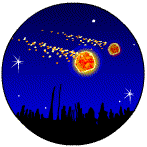Perseids Meteor Shower Project
Created | Updated Jan 28, 2002

The Perseids meteor shower is one of the most observed every year. This is due in part to the fact that it occurs at the height of the Northern Hemisphere's summer season, making conditions relatively comfortable for observers.
Active from July 23 through August 20, this famous meteor shower will peak in the early morning hours of August. A bright last quarter moon might interfere with observations around the peak time, making it hard to see the dimmer meteors. Usually, the Perseids can be counted upon to provide displays of 50-75 meteors per hour during its peak, but even with the moonlight, observers can expect a good show.
The radiant1 lies in the northeastern sky in the constellaton of Perseus. The American Meteor Society website contains a lot of great information about the upcoming Perseid shower.
What we're trying to do on h2g2
h2g2 seems to be a superb place to coordinate a joint global survey of the meteor shower from many countries around the world simultaneously. If each person that watches counts how many they see in various periods of time, we can collate that information from your different locations and time-zones, and see if what you saw in the sky
matched up with what astronomers are expecting to see.
On the night of the 12th and 13th August, we aim to have lots of people out in their backyards, or out in parks, watching the skies and recording some basic information about any shooting stars they see.
Get together with a few friends, take a picnic or some beers (if you're allowed) and make a fun night of it. Shooting stars really are amazing to watch, when you consider what is really going on - chunks of rock, some the size of small cars, plummetting through the upper atmosphere and exploding and rolling and burning up as they hit the air. And they're pretty too!
At the 'maximum', it's not unusual to see about 60 meteors per hour, although some years have had as many as 200 - that's roughly one every 18 seconds! Nearly half of them also leave 'persistent trains' - i.e. you can see their glowing trails for a second or two after the meteor itself has burned away.
When and where to look
Because the swarm of rocks that makes up the Perseids is quite spread out in space, the Earth moves through them over a period of weeks, reaching the thickest part of the rocky cloud around the 12th and 13th of August. This is called the 'maximum', and is when the most meteors can be seen in any given time period. Meteor observers try to count how many they see per hour, and there are some electronic devices that can easily capture every single one if you don't want to sit out all night2.
If you do want to watch the display - and the Perseids are certainly the ones to watch - here's what you should do:
- Get a nice comfy chair, or lie on the grass.
- Look roughly south and upwards at about 45 degrees. If you look straight at the radiant point, you probably won't see many because they'll be coming straight towards you. You want to look at the other parts of the sky where the meteors will hit the atmosphere.
- Make a note of the time. The show will start getting good at about 10pm local time when the planet starts to rotate into the heart of the debris cloud, but the best time is about 1am, continuing on until dawn.
- Count how many meteors you see in each 1/2 hour
When you've had enough, write down what you saw with your observations in the sort of format you can find on the results page3. You can put a posting in a forum at the results page, telling Jimi X what your results were. He'll count them up and tell everyone what happened on that fateful night, as seen from many places all over the world!
Of course, if you can record things like which direction each of them was headed, how fast it went, how bright it was, whether the trail was left in the sky afterwards, etc. etc. that would be fabulous. If one ploughs into your house, we'd quite like to know about that as well...
Have a great night, and don't forget to make lots of wishes!
That's it really. Go check out Yeliab Salohcin's page for more information about the Perseids and to see sample observation charts which you should be able to print.
